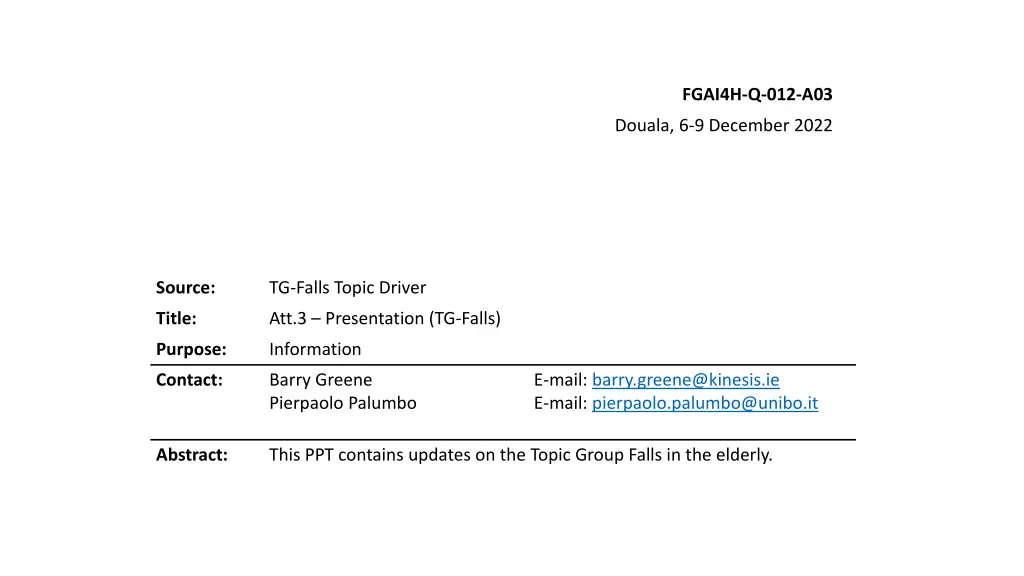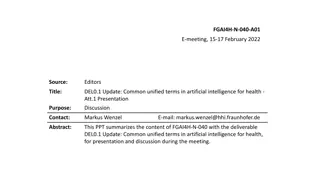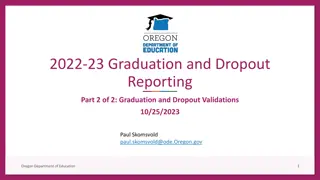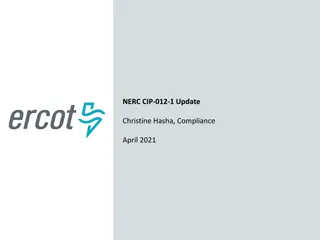
Updates on Wearable Sensor-Based Fall Risk Assessment
Stay informed with the latest updates on wearable sensor-based fall risk assessment in the elderly population. Learn about ongoing systematic reviews, meta-analyses, datasets, and research teams contributing to the advancement of fall prediction technologies. Dive into the prognostic value of features derived from wearable inertial sensors and explore the systematic analysis of publicly available datasets for comprehensive fall risk assessment models.
Download Presentation

Please find below an Image/Link to download the presentation.
The content on the website is provided AS IS for your information and personal use only. It may not be sold, licensed, or shared on other websites without obtaining consent from the author. If you encounter any issues during the download, it is possible that the publisher has removed the file from their server.
You are allowed to download the files provided on this website for personal or commercial use, subject to the condition that they are used lawfully. All files are the property of their respective owners.
The content on the website is provided AS IS for your information and personal use only. It may not be sold, licensed, or shared on other websites without obtaining consent from the author.
E N D
Presentation Transcript
FGAI4H-Q-012-A03 Douala, 6-9 December 2022 Source: TG-Falls Topic Driver Title: Att.3 Presentation (TG-Falls) Purpose: Information Contact: Barry Greene Pierpaolo Palumbo E-mail: barry.greene@kinesis.ie E-mail: pierpaolo.palumbo@unibo.it Abstract: This PPT contains updates on the Topic Group Falls in the elderly.
Ongoing activities Systematic review and individual participant data meta-analysis Commentary
Systematic review and individual participant data meta-analysis Review title: Systematic review and individual participant data meta-analysis of publicly available datasets for wearable inertial sensor-based fall risk assessment Review on datasets for wearable inertial sensor- based fall prediction Aim/question: Which datasets are available for training and validating models for wearable inertial sensor- based fall risk assessment? * What is the prognostic value for falls of features derived from wearable inertial sensors? Analyses on the pooled dataset * Khan, S. M. et al. A global review of publicly available datasets for ophthalmological imaging: barriers to access, usability, and generalisability. Lancet Digit. Heal.3, e51 e66 (2021).
Systematic review and individual participant data meta-analysis Review team: Jose Luis Albites Sanabria, University of Bologna, Bologna, Italy Barry Greene, Kinesis Health Technologies Ltd, Dublin, Ireland Killian McManus, Kinesis Health Technologies Ltd, Dublin, Ireland Luca Palmerini, University of Bologna, Bologna, Italy Pierpaolo Palumbo, University of Bologna, Bologna, Italy In s Sousa, Fraunhofer Portugal AICOS, Porto, Portugal Kimberley S. van Schooten, University of New South Wales, Sydney, Australia Review of datasets for wearable inertial sensor- based fall prediction Analyses on the pooled dataset Two sub-teams for screening and feature extraction. Each sub-team: 2 independent reviewers 1 reviewer for solving disagreement
Systematic review and individual participant data meta-analysis Inclusion criteria: Peer-reviewed articles/conference proceedings in English including datasets with the following characteristics: Datasets including at least 20 individuals Datasets where the predicting features comprised of at least one inertial sensor-based feature Datasets from any community-dwelling population Datasets with individual-level (not aggregated) information about falls* Falls collected after the predicting features (prospective design) # Review on datasets for wearable inertial sensor- based fall prediction * occurrence of at least one fall in a given time period OR number of falls OR date of first fall occurrence # retrospective studies included only for sensitivity analyses Analyses on the pooled dataset Registration: PROSPERO 2022 CRD42022367394
Systematic review and individual participant data meta-analysis Features to extract: Sampled population Sample size Geographic location Clinical features for fall prediction Protocol for inertial sensor assessment (sensor location, measurements during standardized task/free living) Characteristics of inertial sensors (e.g. only accelerometer, acc. + gyro, etc.) Protocol for collecting fall information (fall diaries, phone calls, etc.) Dataset accessibility (open access, open access with barriers, regulated access, not accessible) Review on datasets for wearable inertial sensor- based fall prediction Analyses on the pooled dataset
Systematic review and individual participant data meta-analysis Access request: Email Form: rationale, data management, authorship policy (https://www.icmje.org/recommendations/browse/roles-and- responsibilities/defining-the-role-of-authors-and-contributors.html) Review on datasets for wearable inertial sensor- based fall prediction Meta-analysis: Data storage facility: secure, large (AWS?) Two possibilities Share data: one-stage IPD meta-analysis Share only algorithms and results: two-stage IPD meta-analysis Univariate analysis: i) ORs, RaRs, and HRs, ii) Mixed-effect logistic regressions Multivariate model * Analyses on the pooled dataset * Ahmed I, Debray TPA, Moons KGM, Riley RD. Developing and validating risk prediction models in an individual participant data meta-analysis. BMC Med Res Methodol. 2014;14(3).
Systematic review and individual participant data meta-analysis Google Dataset Search Mendeley Data, IEEE DataPort, Physionet, Figshare, Dataverse, Dryad, hand search PubMed: 26 reviews, Web of Science: 23 reviews, Scopus: 33 reviews To do 19 unique review articles 834 articles to screen 18 duplicates removed 816 articles screened for title and abstract 690 articles excluded 126 articles to screen for full- text eligibility To do Feature extraction Access request One/two-stage IPD meta-analysis
Commentary Decision tree for fall risk stratification, assessment, and intervention Two entry points: i) opportunistic/annal health visit, ii) presenting to healthcare after a fall Three binary split nodes: i) history of falls or 3KQ, ii) fall severity, iii) gait and balance impairment Three output risk strata. i) low, ii) intermediate, iii) high risk
Commentary Our viewpoint on fruitful research on fall risk estimation Validation Need for validating newly proposed algorithms Need for acknowledging existing externally-validated algorithms Need for comparing new and existent algorithms Need for modelling opportunistic case finding, different screening frequencies Usability Need for setting usability criteria of fall risk tools (software, sensor equipment, administration time) Need for calibrating the outputs of fall risk tools upon healthcare system s capacity to provide preventive intervention Need for adapting these usability criteria according to setting and region Personalised prediction vs recommendation Need for making research on personalised recommendation
Commentary State of our activities Commentary, version 1: Drafted Circulated among active TG members + representative of the FG (Eva Weicken, Markus Wenzel) Feedback received Commentary, version 2: Drafting in progress










